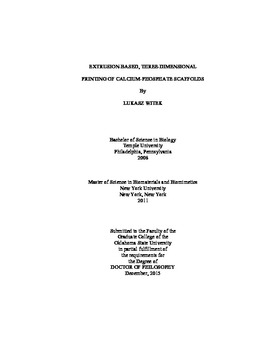| dc.contributor.advisor | Smay, James E. | |
| dc.contributor.author | Witek, Lukasz | |
| dc.date.accessioned | 2016-09-29T18:47:01Z | |
| dc.date.available | 2016-09-29T18:47:01Z | |
| dc.date.issued | 2015-12 | |
| dc.identifier.uri | https://hdl.handle.net/11244/45387 | |
| dc.description.abstract | Small or large bone defects, can occur due to a variety of reasons: congenital disorders, infections, tumors, or traumas which can lead to significant disabilities. There is an assortment of bone grafting procedures, each having their own respective advantages and disadvantages and exhibiting certain essential characteristics. Among the available grafts, autogenous (autograft), allograft, xenograft, and alloplasts, all exhibit a minimum of two-thirds of the essential characteristics and have been proven useful in fully or partially repairing skeletal defects. However, different host-to-grafting material responses have been reported and should be taken into consideration when determining treatment options. A large range of physical and chemical properties can be achieved with calcium phosphate based materials, which possess two of the ideal characteristics for grafting procedures: osteoconduction and osseointegration. Calcium phosphate based scaffolds composed of hydroxyapatite (HA), B-tri-calcium phosphate (B-TCP), or a combination of both (HA/B-TCP) were investigated as materials for three-dimensional printing process to create layer-by-layer structures for use as bone regeneration scaffolds. Different calcium-phosphate phases will result in different degrees of in vivo dissolution and/or cell-mediated resorption. There has been a growing interest in BCP because it has been shown that this material improves the formation of new bone inside the implanted scaffold. The literature indicates that the faster dissolution rate of B-TCP would be greatly responsible of this enhancement. However, in vitro tests indicate that fast dissolution can decrease the mechanical strength of BCP scaffolds. Furthermore, studies reported that HA has higher mechanical strength and lower degradation rate than B-TCP. Therefore, the HA/B-TCP ratio is a key parameter controlling the performance of the scaffold for bone repair applications, since it determines degradation rate, calcium (Ca2+) and phosphate (PO4) release and mechanical properties of the material. | |
| dc.format | application/pdf | |
| dc.language | en_US | |
| dc.rights | Copyright is held by the author who has granted the Oklahoma State University Library the non-exclusive right to share this material in its institutional repository. Contact Digital Library Services at lib-dls@okstate.edu or 405-744-9161 for the permission policy on the use, reproduction or distribution of this material. | |
| dc.title | Extrusion-based, three-dimensional printing of calcium-phosphate scaffolds | |
| dc.contributor.committeeMember | Rhinehart, R. Russell | |
| dc.contributor.committeeMember | Ramsey, Joshua D. | |
| dc.contributor.committeeMember | Sarin, Pankaj | |
| dc.contributor.committeeMember | Hanan, Jay | |
| osu.filename | Witek_okstate_0664D_14430.pdf | |
| osu.accesstype | Open Access | |
| dc.type.genre | Dissertation | |
| dc.type.material | Text | |
| thesis.degree.discipline | Chemical Engineering | |
| thesis.degree.grantor | Oklahoma State University | |
